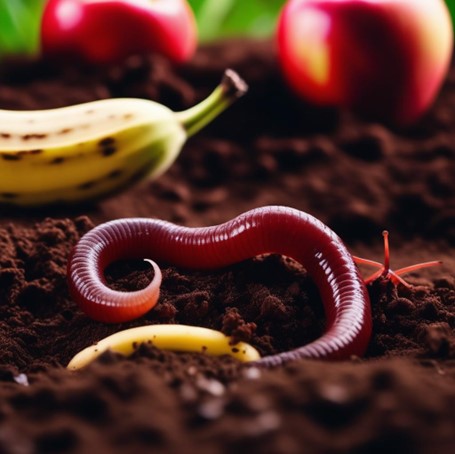
Contents
Learning Outcome Time required Tools or equipment required Summary of the activity What to do Tips how to implement the topic to school curriculumLearning Outcome
After finishing this activity a student will have learned to:
- get to know some infromation about soil edaphone how it is work
- get to know which food and things are fine for edaphone
- think about how to reduce food waste and food wasting both at home and at the school
- get to know infromation regarding animal behavior
Time required
2 x 45 min for building the earthworm home
Tools or equipment required
- box for the earthworm (for example aquarium – in order to see how earthworms build corridors under the soil)
- soil
- earthworm (more than 6; it depends on the size of the box)
- leftovers from uneaten food
- gloves for pupils
Summary of the activity
The objective of this activity is to diminish food waste within the school. Students prepared a box with soil and earthworms in just a few minutes. This activity demonstrates to students how earthworms function and consume remnants of uneaten food.
Another aspect is to reduce food waste and engage in something beneficial rather than discarding their uneaten food as rubbish. Students can analyze the amount of food wasted and identify the grade levels that contribute significantly to food waste.
What to do
1. Introduction to the Topic
To kick off our exploration, we will commence with an engaging introduction to the critical issue of food waste. Consider presenting a compelling video (Video 1) or a multimedia presentation showcasing the extent of the food waste problem. Additionally, display another video (Video 2 ) that explores existing earthworm homes and the outcomes of similar projects.
Utilize the Kahoot application to assess the class's baseline knowledge about the topic. Incorporate questions related to soil enrichment and potential solutions to food waste, fostering an interactive and dynamic learning environment.
Next, clarify the purpose of our activity and outline your expectations for the students. The primary goals are to create an earthworm home, comprehend its functionality, and learn how to maintain and care for the earthworms.
2. Research
Guide the students through the research phase, aiding them in formulating conclusions about the connection between food waste and the crucial role earthworms play in soil transformation. Encourage them to delve into specific aspects, such as:
-
Earthworm Preferences: Investigate and document the types of food that earthworms prefer the most. This insight will contribute to a better understanding of their diet and, consequently, their effectiveness in processing different types of organic waste.
-
Transformation Speed: Challenge the students to analyze and measure the rate at which earthworms convert food into nutrient-rich soil. This aspect is vital in assessing the efficiency of earthworms as natural decomposers.
Throughout the research process, emphasize critical thinking and active participation. Foster an environment where students can share their findings and engage in collaborative discussions, promoting a deeper comprehension of the intricate relationship between earthworms and food waste transformation.
By the end of this activity, students will not only have practical experience in creating and maintaining an earthworm home but will also have gained valuable insights into the ecological role of earthworms in mitigating the issue of food waste.
3. Evaluation and Assessment:
- Implement a comprehensive assessment strategy that includes practical components, research papers, presentations, and collaborative discussions.
- Assess students on their ability to apply scientific principles, critical thinking skills, and their understanding of the broader environmental context.
Tips how to implement the topic to school curriculum
1. Biology Curriculum:
- Position this activity within the biology curriculum, specifically within units that cover ecosystems, environmental science, or ecology.
- Align the investigation with lessons on decomposition, nutrient cycling, and the role of organisms in maintaining ecosystem balance.
2. Cross-Disciplinary Integration:
- Collaborate with other subjects, such as Chemistry (studying soil composition) and Environmental Science (examining broader environmental impacts of food waste).
- Connect the project with English classes by assigning research papers or presentations on the broader implications of food waste.
3. Practical Application in Home Economics:
- Integrate the project into Home Economics or Life Skills classes to emphasize the practical aspects of reducing food waste at home and in the community.
- Explore aspects of sustainable living, gardening, and composting within the context of the curriculum.
4. Student-Led Initiatives:
- Encourage students to take ownership of the project by forming eco-clubs or environmental committees.
- Empower them to organize awareness campaigns within the school, fostering a sense of responsibility and environmental stewardship.
5. Technology Integration:
- Leverage technology for research and presentations. Incorporate digital tools for data analysis and encourage students to create multimedia presentations showcasing their findings.
- Utilize online platforms for collaborative learning and information sharing.
6. Field Trips and Guest Speakers:
- Enhance the curriculum by organizing field trips to local farms, composting facilities, or environmental organizations.
- Invite guest speakers, such as environmental scientists or practitioners, to provide real-world perspectives on the importance of earthworms in waste management.
7. Long-Term Sustainability Projects:
- Transform this activity into a long-term sustainability project by establishing and maintaining an on-site worm composting system.
- Integrate ongoing monitoring and periodic evaluations into the curriculum to reinforce the importance of sustained environmental efforts.
By weaving this interdisciplinary and hands-on project into various subjects, students not only gain a deep understanding of the scientific concepts but also develop practical skills and a heightened awareness of their role in environmental conservation. This approach fosters a holistic and engaging educational experience that extends beyond the classroom.
